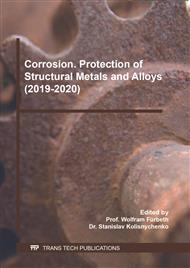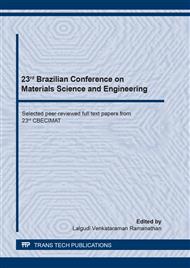p.377
p.385
p.390
p.395
p.401
p.407
p.412
p.418
p.424
Study of Corrosion Behavior of Friction Surfacing AA6351 Aluminium Alloy Coating on AISI 1020 Low Carbon Steel
Abstract:
In the present work, the friction surfacing process was applied to manufacture aluminum alloy (AA6351) coatings on low carbon steel (AISI 1020) substrates. After friction surfacing the AA6351 deposited coatings were submitted to two finishing process in order to adjust surface roughness: milling and milling followed by sanding. The corrosion behavior of the two finishing process was compared with the as-deposited condition in order to determine the influence of surface roughness on the corrosion resistance of friction surfacing coatings. The corrosion behavior was examined by electrochemical impedance spectroscopy and potentiodynamic polarization in a 3.5wt.%NaCl solution containing naturally dissolved O2. The results obtained indicated that the elevated surface roughness observed in the as-deposited condition led to relatively lower corrosion resistance in comparison, with lower values for polarization resistance and more anodic corrosion potential.
Info:
Periodical:
Pages:
401-406
Citation:
Online since:
October 2020
Keywords:
Price:
Сopyright:
© 2020 Trans Tech Publications Ltd. All Rights Reserved
Share:
Citation:



